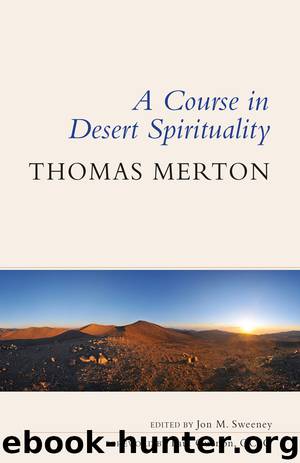A Course in Desert Spirituality by Thomas Merton

Author:Thomas Merton
Language: eng
Format: epub
Publisher: Liturgical Press
Published: 2019-03-18T16:00:00+00:00
Degrees of Prayer Summary
1) Preliminaries: In order to enter upon the life of prayer one must be detached from objects. Evagrius distinguishes detachment from objects and from the thoughts of objects. Here we are pretty much on the same ground as in Cassian, Conference 3.
2) Apatheia—The true life of prayer begins when one has not only left behind the things of earth, but is beginning the struggle with thoughts of those things. The first step in the life of prayer is the struggle with “passionate thoughts,” i.e., thoughts that move us to passion, whether anger, lust, etc. Here, meditation is important, including the constant meditation of death and the last things, until the soul begins to be free. Here the big thing is virtue. Note—combat with evil spirits is crucial. According to Evagrius (Or. 49), the chief purpose of the battle waged by devils against the monk is to prevent or to frustrate interior prayer. The devils tempt us to those vices most contrary to prayer, especially lust and anger. Apatheia is the victory of the soul over all the devils (i.e., all the passions). Note that apatheia is not mere insensibility. It is compounded of humility, compunction, zeal, and intense love for God. Apatheia is the state of a soul that is no longer moved by passionate thought. The thoughts of such souls are “simple,” that is to say, untainted by passion: they have no “charge” of passion in them; we simply see objects as they are, in simplicity. At this point one reaches the stage of “meditation on simple thoughts.” Note that prayer is inseparably connected with virtue. Without virtue, one cannot resist passion, and if one is dominated by passion, he has no control of thoughts and cannot pray. However, Evagrius always insists that prayer is a pure gift of God; it is not attained by our own ascetic efforts but we must beg Him for the gift of prayer (Or. 58).
3) Spiritual Contemplation—Gnosis and Theoria Physica. The mind is now beyond simple thoughts but it receives in itself the form of the essences of things—an intuitive penetration of reality—of “nature” in so far as it reflects God. This, in other words, is an intuition of the Creator in His Creation. The logoi of creatures are reflections of the divine attributes. He says that in theoria physica we “receive letters” from God, but in the highest contemplation we speak to Him and He speaks to us. (Cf. St. John of the Cross, Spiritual Canticle, 2:3.) In the highest contemplation God is present directly to the mind without form or concept. In “Spiritual Contemplation” (gnosis), though the soul possesses apatheia, the devil can still tempt it—but now not with passions—rather he injects into the mind spiritual forms, images and visions which claim to “represent” God or divine things (Or. 67–68). In the highest contemplation (Theologia) the soul is beyond the reach of the devil because it no longer uses any concepts whatever and is pure of “all forms,” and cannot be deceived by any false idea.
Download
This site does not store any files on its server. We only index and link to content provided by other sites. Please contact the content providers to delete copyright contents if any and email us, we'll remove relevant links or contents immediately.
| Clergy | Devotionals |
| Faith | Inspirational |
| Meditations | Monasticism & Asceticism |
| Prayer | Prayerbooks |
| Ritual | Sermons |
The Secret Power of Speaking God's Word by Joyce Meyer(2969)
More Language of Letting Go: 366 New Daily Meditations by Melody Beattie(2966)
The Holy Spirit by Billy Graham(2892)
To Light a Sacred Flame by Silver RavenWolf(2767)
Tuesdays With Morrie by Mitch Albom(2688)
The Lost Art of Good Conversation by Sakyong Mipham(2576)
The Traveler's Gift by Andy Andrews(2409)
Kundalini by Gopi Krishna(2136)
A Kingsbury Collection by Karen Kingsbury(2059)
Angels of God: The Bible, the Church and the Heavenly Hosts by Mike Aquilina(1932)
Finding Chika by Mitch Albom(1926)
Anxious for Nothing by Max Lucado(1910)
Angels by Billy Graham(1886)
As a Man Thinketh by James Allen(1861)
Curse Tablets and Binding Spells from the Ancient World by Gager John G.;(1837)
The Yoga of Jesus: Understanding the Hidden Teachings of the Gospels by Paramahansa Yogananda(1803)
Barking to the Choir by Gregory Boyle(1786)
Autobiography of a Yogi (Complete Edition) by Yogananda Paramahansa(1774)
How To Be Born Again by Billy Graham(1730)
